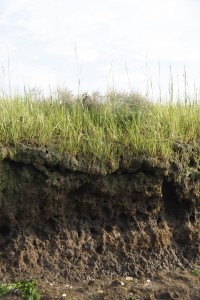Based on research by Hayoon Chung, MIT ’16
Coastline Protection:
The roots of salt marsh plants play a significant role in protecting our coastline. The roots, strong and intricate, are able to hold onto the soil. When the tides and storms come in the soils of the coastline are not washed away. This helps considerably against erosion: the process by which the elements, such as wind and water, wash away sediments and deposits them elsewhere.
Erosion is a threat to many coastlines, however, salt marshes help mitigate the affects and keep the soils from washing away.
Vegetation along the salt marshes also protect the coast against strong storms. Cord grasses and reeds can grow up to 7 feet and absorb the force of storm surges and current energy. The plants play a role of wind-breaks, reducing the damaging effects of storms considerably.
Salt Marsh Filtration:
As the area in between land and the ocean, salt marshes serves an important role: that of filtration. Salt marshes filter surface run-off, which often includes toxic chemicals, fertilizers, and other contaminants. They filter nutrients, like nitrogen and phosphorus, that are harmful when they enter the ocean directly
The balance of many ecosystems can be ruined when too much nitrogen or phosphorus enters the ocean.
When increased amounts of nitrogen enter the ocean there is an algae bloom. Such overwhelming amount of algae not only damages the population balance (those that feed on algae will overpopulate while other organisms may become under-populated), but also creates a shade-mat. When the algae dies, it will float on top of the ocean and create a giant shade, preventing sunlight from reaching the underwater. This reduces productivity and leads to the destruction of certain habitats. Unfortunately, humans use phosphorus and nitrogen for many things: fertilizer and pesticides, and the harmful nutrients inevitably run-off into the ocean. Salt marshes help reduce the effects of such human environmental degradation.
Salt Marshes and Carbon Sequestration:
Carbon Sequestration is the process by which air-borne carbon, carbon dioxide, is captured and stored. Scientists continue to research the various processes of Carbon Sequestration in order to find a way to battle global warming.
Co2 positive feedback cycle: Salt marshes play an important role in putting carbon back into the earth. They absorb gaseous carbon – carbon dioxide – and enter it back into the soil. By fixing it in the soil and preventing its release into the air, this process is highly beneficial to slow global warming and other harmful effects of high carbon content in the atmosphere.

Even though the salt marsh is capable of removing carbon dioxide from the air and storing it as
biomass, it is only capable of doing so if it is a healthy marsh. When a marsh is destroyed, usually because of human impact, and the organisms die, all the carbon that had been absorbed and stored in the biome will be released back into the air as carbon dioxide. This increase in carbon dioxide further agitates global warming, which can in turn destroy even more salt marshes. This leads to a cycle of worsening conditions, otherwise known as a positive feedback cycle.
Pollution and its Effects:
Salt marshes have the amazing ability to filter nutrients and toxins. However, there is a limit to how much they can hold.